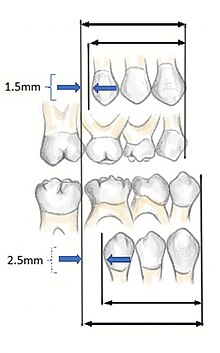Leeway Space
Under the leeway space ( German margin ) is understood in the dentistry the gain in space during the dentition . The erupting premolars are smaller than the milk teeth that they replace. This allows the permanent molars to drift mesially into the gaps and develop an occlusion of Angle class I (neutral bite, “normal bite”). The difference in millimeters between the sum of the mesio-distal tooth widths of the deciduous canine and the first and second deciduous molars on the one hand and the sum of the mesio-distal widths of the subsequent permanent teeth, namely the canine and the first and second premolars, on the other hand, results in the space gain . In each quadrant (one half of the jaw) there is a 2–3 mm reserve space in the lower jaw and 1–2 mm in the upper jaw . This can also be used therapeutically in orthodontics if the teeth are crowded .
Individual evidence
- ^ Mary Bath-Balogh, Margaret J. Fehrenbach: Illustrated Dental Embryology, Histology, and Anatomy - E-Book . Elsevier Health Sciences, April 11, 2014, ISBN 978-0-323-29086-9 , p. 276.
- ↑ E. Löhr, B. Marzotko, D. Eismann: On the importance of the "lee-way space" and the order of the posterior tooth change for the space in the canine and premolar area. In: Advances in Orthodontics. 48, 1987, p. 416, doi : 10.1007 / BF02163482 .
- ↑ Mathew M. Brennan, Anthony A. Gianelly: The use of the lingual arch in the mixed dentition to dissolve the front narrowing. In: Information from Orthodontics & Orthodontics. 33, p. 205, doi : 10.1055 / s-2001-15754 .
